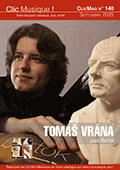 La musique de chambre de Schumann a été composée à des périodes bien précises de la vie du compositeur, 1842, 1847, et à un moindre degré, 1851. C'est notamment le cas des quatuors, exemple de compartimentation extrême? puisqu’en un peu plus d’un mois les trois étaient achevés. Dans la même année suivirent le Quintette et le Quatuor avec piano (non enregistrés ici). Les deux premiers trios datent de 1847. Ces pièces sont à maints égards un "précipité", une sorte de miroir fascinant de toute l'œuvre. Une mise en abyme, pourrait-on dire. Le célèbre dualisme Eusébius/Florestan, opposant rêverie, méditation et lyrisme d’une part, énergie, dramatisme, et fureur d'autre part, auquel Schumann a rapporté toute sa production et sa difficulté à être, revêt une acuité particulière dans ces pages. Le grand mérite des interprètes est de prendre à bras-le-corps ces partitions, en s’ y engageant totalement pour faire admirablement ressentir cet aspect contradictoire et ces continuels passages des sommets aux abîmes, de l'extase immobile et suspendue aux chevauchées, aux soubresauts, à l'inquiétude, aux obsessions, voire à la noirceur. Le 1er trio est à n'en pas douter le plus haut sommet de ce coffret : les musiciens portent et emportent l'œuvre à un rare degré d'incandescence?, et les membres du quatuor Via Nova, avec J. Hubeau au piano, apparaissent, par comparaison, bien sages. Rimbaud qui n'était pas un romantique, parlait, en définissant sa poésie, de "la pensée accrochant la pensée et tirant". Le Schumann des Savinio est un Schumann qui "accroche l'âme et qui tire" pourrait-on dire, en déformant Rimbaud. Le lyrisme du second trio est lui aussi magnifiquement servi, dans une ferveur rayonnante. Notons que dans le quatuor n° 2, toutes les reprises sont faites, contrairement à ce qui vaut dans d’autres versions. Si l'on peut préférer dans l’op. 41 n°3, l'interprétation des Manfred, l'ensemble du coffret se révèle d'un excellent niveau. La réputation de ce quatuor italien, déjà distingué et récompensé dans d'autres répertoires (quatuors de Cherubini notamment), et considéré comme l'héritier du Quartetto italiano, n'est d'ailleurs plus à faire. (Bertrand Abraham)  Schumann composed his three string quartets and the Fantasiestücke Op.88 in his ‘chamber music year’ of 1842, while preparing for the two oratorios which he regarded as his greatest work in any medium, Paradise and the Peri (1843) and the Scenes from Goethe’s Faust, which preoccupied him on and off for the next decade. Posterity has however been less kind to these large-scale summations than the song cycles and chamber works, such as those recorded here, in which the composer’s obsessive reworking of small motifs finds consistently impassioned expression. As befits their place within the canon of the genre, the string quartets are often densely and contrapuntally worked, whereas the piano-trio Fantasiestücke are more characteristic of Schumann the lyric poet, whether for voice or instruments. These four pieces are cast as a sonata manqué, with a soulful prelude, lively Scherzo, yearning duet for the two string instruments and combative finale. They have not received the attention they deserve from either performers or listeners, but they are fully the equal of the three piano trios proper in which, according to Alfred Einstein, can best be heard the composer’s self-declared dual nature as both Florestan and Eusebius, impetuous man of action and melancholy dreamer. Joy and exuberance are their keynotes. The Quartetto Savinio has been acclaimed by a native critic as the ‘true heir to the Quartetto Italiano’, and its musicians were coached by the violist of that ensemble, Piero Farulli. With an all-Italian line-up, the quartet has worked with many contemporary composers from their own country, and won both awards and critical praise for a previous recording of the string quartets by Luigi Cherubini: it is an Italian ensemble through and through. The Florentine pianist Matteo Fossi has recorded for Decca (including much of Brahms’s two-piano repertoire with his regular duet partner, Marco Gaggini) and Brilliant Classics, notably the piano quartets of Schumann with Quartetto Klimt (BC95012).
 |
